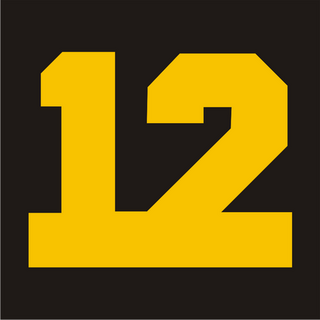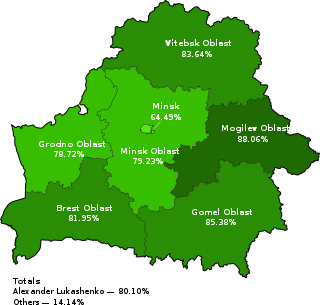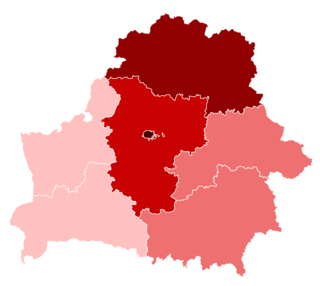
Vitebsk or Viciebsk, is a city in Belarus. The capital of the Vitebsk Region, it has 366,299 inhabitants, making it the country's fourth-largest city. It is served by Vitebsk Vostochny Airport and Vitebsk Air Base.

The Byelorussian Soviet Socialist Republic, also commonly referred to in English as Byelorussia, was a republic of the Soviet Union (USSR). It existed between 1920 and 1922, and from 1922 to 1991 as one of fifteen constituent republics of the USSR, with its own legislation from 1990 to 1991. The republic was ruled by the Communist Party of Byelorussia and was also referred to as Soviet Byelorussia by a number of historians.

Vitebsk Region or Vitebsk Oblast or Viciebsk Voblasts is a region (oblast) of Belarus with its administrative center being Vitebsk. It is located near the border with Russia.

Orša is a city in Belarus in the Vitebsk Region, on the fork of the Dnieper and Arshytsa rivers.

Byelorussia, known today as Belarus, was a republic of the Soviet Union when World War II began. The borders of Belarus were greatly expanded in the invasion of Poland of 1939 and finalised after World War II. Following the German military disasters at Stalingrad and Kursk, a collaborationist Belorussian self-government (BCR) was formed by the Germans in order to drum up local support for their anti-Soviet operations. The Belorussian BCR in turn formed the twenty-thousand strong Belarusian Home Defence (BKA), active from 23 February 1944 to 28 April 1945. Assistance was offered by the local administrative governments from the Soviet era, and prewar public organizations including the former Soviet Belarusian Youth. The country was soon overrun by the Red Army. Devastated by the war, Belarus lost significant populations and economic resources. Many battles occurred in Belarusian and neighbouring territory. Belarusians also participated in regional conflicts.

Victory Square is a square in Minsk, Belarus, located at the crossing of Independence Avenue and Zakharau Street. The square is located in the historic centre of Minsk with the Museum of the 1st Congress of RSDLP, the main offices of National State TV and Radio and the City House of Marriages nearby. A green park stretches from Victory Square to the Svislach River and to the entrance to Gorky Park. Victory Square is the key landmark of Minsk, and holiday parades go through the square, while newlyweds traditionally take their picture at the square.

Rasony District is a district in Vitebsk Region, Belarus.

Independence Day of the Republic of Belarus, also known as Republic Day or Liberation Day is a public holiday, the independence day of Belarus and is celebrated each year on 3 July. Independence Day is a non-working day.

The Church of St. Barbara is a Catholic church and the parish in Vitebsk a city in Belarus.

The 2017 Belarusian protests were a series of demonstrations and street protests against President Alexander Lukashenko that broke out in late February 2017. Protesters mobilized against a tax levied against the unemployed in Belarus. Demonstrations and marches were held in sites throughout the country with sizes of several hundred to several thousand gathering at a given time.

The Minsk Independence Day Parade also known as the July 3 Parade is the main event of the Independence Day of Belarus. This parade is held annually in Minsk on July 3 and is one of the most frequently held military parades in Eastern Europe, as well as the former Soviet Union. It is held every year except years that celebrate Victory Day, to which Victory Day Parades are held.
The Partisans Parade was a solemn Red Army and partisan victory parade held on 16 July 1944 on the field of the former Hippodrome in Minsk on the dedicated to the liberation of Minsk from the German occupation in the 3 July Minsk Offensive. The offensive was part of the Soviet Belorussian Strategic Offensive Operation.

Tuzin.fm is a private non-profit Belarusian web-portal, which was created in 2003 to cover musical creativity in Belarus. Among its objectives, the site promotes music written in Belarus and motivates to listen to Belarusian songs as large an audience as possible. It initiates and implements music projects and is the information partner of the most significant events of the Belarusian independent music scene. Independently determining its information policy, the nature and content of the information, advertising, audio, and video materials, in 2009 the mass media had more than 50 thousand monthly visitors who downloaded more than 80 thousand songs.

Presidential elections were held in Belarus on Sunday, 9 August 2020. Early voting began on 4 August and ran until 8 August.

The COVID-19 pandemic in Belarus is part of the ongoing worldwide pandemic of coronavirus disease 2019 caused by severe acute respiratory syndrome coronavirus 2. The virus was confirmed to have spread to Belarus, when the first case of COVID-19 in the country was registered in Minsk on 28 February 2020.

The 2020–2021 Belarusian protests were a series of mass political demonstrations and protests against the Belarusian government and President Alexander Lukashenko. The largest anti-government protests in the history of Belarus, the demonstrations began in the lead-up to and during the 2020 presidential election, in which Lukashenko sought his sixth term in office. In response to the demonstrations, a number of relatively small pro-government rallies were held.
Alexander Taraikovsky was a demonstrator who died in Minsk, Belarus, during the 2020 Belarusian protests in which the police used tear gas, rubber bullets, and stun grenades against peaceful protestors. He was the first victim whose death was officially confirmed.
The Square of Changes is the name of a popular courtyard in Minsk, Belarus, located at the intersection of Chervyakov, Kakhovskaya, and Smorgovsky streets. It appeared spontaneously in August 2020 during the protests after the sixth presidential election in Belarus. On the wall of a ventilation booth, unknown people painted a mural of two sound engineers from the Minsk State Palace of Children and Youth, who played Viktor Tsoi's song "Khochu Peremen" at the official pro-Lukashenko event on August 6, 2020 in Kiev Square, Minsk.















